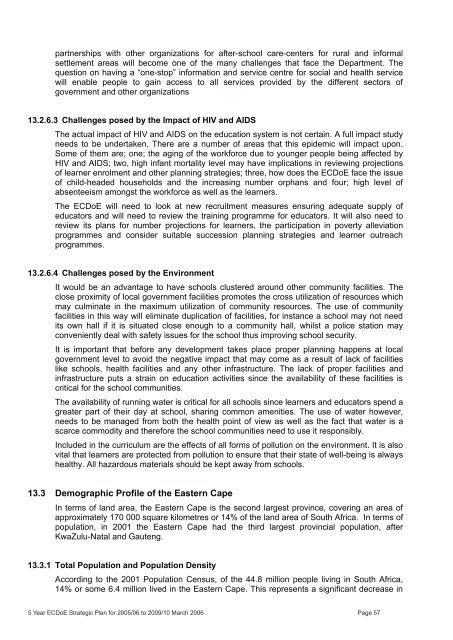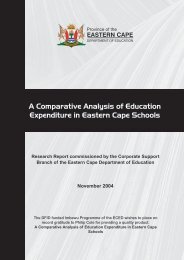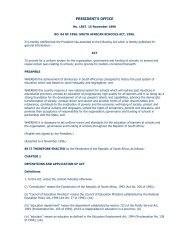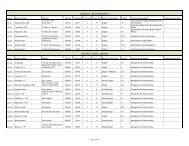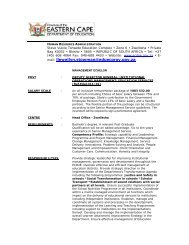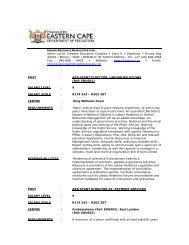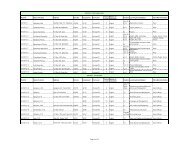part a: strategic overview - Department of Education
part a: strategic overview - Department of Education
part a: strategic overview - Department of Education
You also want an ePaper? Increase the reach of your titles
YUMPU automatically turns print PDFs into web optimized ePapers that Google loves.
<strong>part</strong>nerships with other organizations for after-school care-centers for rural and informal<br />
settlement areas will become one <strong>of</strong> the many challenges that face the De<strong>part</strong>ment. The<br />
question on having a “one-stop” information and service centre for social and health service<br />
will enable people to gain access to all services provided by the different sectors <strong>of</strong><br />
government and other organizations<br />
13.2.6.3 Challenges posed by the Impact <strong>of</strong> HIV and AIDS<br />
The actual impact <strong>of</strong> HIV and AIDS on the education system is not certain. A full impact study<br />
needs to be undertaken. There are a number <strong>of</strong> areas that this epidemic will impact upon.<br />
Some <strong>of</strong> them are; one; the aging <strong>of</strong> the workforce due to younger people being affected by<br />
HIV and AIDS; two, high infant mortality level may have implications in reviewing projections<br />
<strong>of</strong> learner enrolment and other planning strategies; three, how does the ECDoE face the issue<br />
<strong>of</strong> child-headed households and the increasing number orphans and four; high level <strong>of</strong><br />
absenteeism amongst the workforce as well as the learners.<br />
The ECDoE will need to look at new recruitment measures ensuring adequate supply <strong>of</strong><br />
educators and will need to review the training programme for educators. It will also need to<br />
review its plans for number projections for learners, the <strong>part</strong>icipation in poverty alleviation<br />
programmes and consider suitable succession planning strategies and learner outreach<br />
programmes.<br />
13.2.6.4 Challenges posed by the Environment<br />
It would be an advantage to have schools clustered around other community facilities. The<br />
close proximity <strong>of</strong> local government facilities promotes the cross utilization <strong>of</strong> resources which<br />
may culminate in the maximum utilization <strong>of</strong> community resources. The use <strong>of</strong> community<br />
facilities in this way will eliminate duplication <strong>of</strong> facilities, for instance a school may not need<br />
its own hall if it is situated close enough to a community hall, whilst a police station may<br />
conveniently deal with safety issues for the school thus improving school security.<br />
It is important that before any development takes place proper planning happens at local<br />
government level to avoid the negative impact that may come as a result <strong>of</strong> lack <strong>of</strong> facilities<br />
like schools, health facilities and any other infrastructure. The lack <strong>of</strong> proper facilities and<br />
infrastructure puts a strain on education activities since the availability <strong>of</strong> these facilities is<br />
critical for the school communities.<br />
The availability <strong>of</strong> running water is critical for all schools since learners and educators spend a<br />
greater <strong>part</strong> <strong>of</strong> their day at school, sharing common amenities. The use <strong>of</strong> water however,<br />
needs to be managed from both the health point <strong>of</strong> view as well as the fact that water is a<br />
scarce commodity and therefore the school communities need to use it responsibly.<br />
Included in the curriculum are the effects <strong>of</strong> all forms <strong>of</strong> pollution on the environment. It is also<br />
vital that learners are protected from pollution to ensure that their state <strong>of</strong> well-being is always<br />
healthy. All hazardous materials should be kept away from schools.<br />
13.3 Demographic Pr<strong>of</strong>ile <strong>of</strong> the Eastern Cape<br />
In terms <strong>of</strong> land area, the Eastern Cape is the second largest province, covering an area <strong>of</strong><br />
approximately 170 000 square kilometres or 14% <strong>of</strong> the land area <strong>of</strong> South Africa. In terms <strong>of</strong><br />
population, in 2001 the Eastern Cape had the third largest provincial population, after<br />
KwaZulu-Natal and Gauteng.<br />
13.3.1 Total Population and Population Density<br />
According to the 2001 Population Census, <strong>of</strong> the 44.8 million people living in South Africa,<br />
14% or some 6.4 million lived in the Eastern Cape. This represents a significant decrease in<br />
5 Year ECDoE Strategic Plan for 2005/06 2005-06 to 2009/10 2009-10. March 21 F (3).doc 2006 Page 57<br />
Page 53


